Births
| | This section is empty. You can help by adding to it. (July 2010) |
| |||
|---|---|---|---|
| +... |
| | This section is empty. You can help by adding to it. (July 2010) |

Peire Cardenal was a troubadour known for his satirical sirventes and his dislike of the clergy. Ninety-six pieces of his remain, a number rarely matched by other poets of the age.
Eudokia Komnene was a relative of Byzantine Emperor Manuel I Komnenos, and wife of William VIII of Montpellier.
The sirventes or serventes, sometimes translated as "service song", was a genre of Old Occitan lyric poetry practiced by the troubadours.
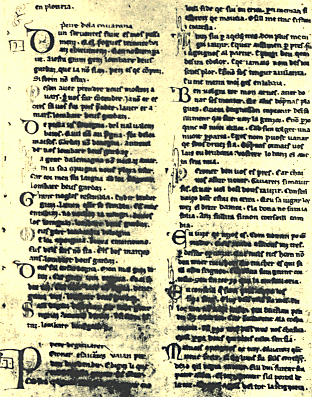
Peire de la Caravana was an Italian troubadour (trovatore) in Lombardy in the late 12th and early 13th centuries. He was one of the earliest Occitan troubadours in Italy. He is famous for his sirventes.
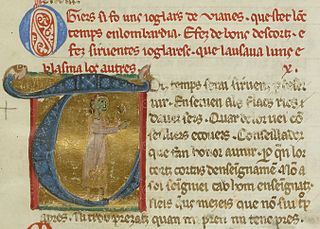
Guillem AugierNovella was a troubadour from Vienne in the Dauphinois who lived most of his adulthood in Lombardy and was active as a minstrel in the early or mid thirteenth century. According to his late thirteenth-century vida, "he composed good descartz and sirventes in the manner of jongleurs, in which he praised some and blamed others."

Guillem or Guilhem Figueira or Figera was a Languedocian jongleur and troubadour from Toulouse active at the court of the Emperor Frederick II in the 1230s. He was a close associate of both Aimery de Pégulhan and Guillem Augier Novella.
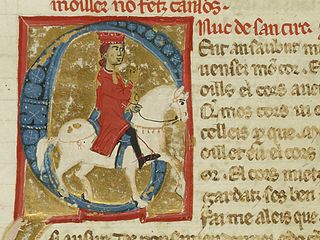
Uc de Saint Circ or Hugues (Hugh) de Saint Circq was a troubadour from Quercy. Uc is perhaps most significant to modern historians as the probable author of several vidas and razos of other troubadours, though only one of Bernart de Ventadorn exists under his name. Forty-four of his songs, including fifteen cansos and only three canso melodies, have survived, along with a didactic manual entitled Ensenhamen d'onor. According to William E. Burgwinkle, as "poet, biographer, literary historian, and mythographer, Uc must be accorded his rightful place as the 'inventor' (trobador) of 'troubadour poetry' and the idealogical trappings with which it came to be associated."
Luchetto Gattilusio was a Genoese statesman, diplomat, and man of letters. As a Guelph he played an important role in wider Lombard politics and as a troubadour in the Occitan language he composed three poems descriptive of his times.
Calega Panzano, Panzan, or Panza was a Genoese merchant, politician and man of letters.

Bertran d'Alamanon, also spelled de Lamanon or d'Alamano, was a Provençal knight and troubadour, and an official, diplomat, and ambassador of the court of the Count of Provence. Twenty-two of his works survive, mainly provocative tensos and sirventes, many dealing with Crusading themes.
Folquet de Lunel was a troubadour from Lunel in the Languedoc. He left behind nine recorded lyric poems, including five cansos, two partimens, and two sirventes. He also wrote one longer work, the Romans de mondana vida. Folquet's birth date can be known precisely because he tells us in his Romans, written in 1284, that he was forty years old at the time.
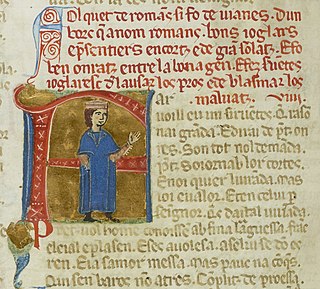
Falquetde Romans was the most famous troubadour attached to the court of Frederick II, Holy Roman Emperor, where he garnered a high reputation despite the fact that his career began as a jongleur. His surviving work consists of fourteen or fifteen pieces: seven sirventes, three tensos, two or three cansos on courtly love, a salut d'amor of 254 lines, and a religious alba. His poetry is, in general, clear and elegant, and he was apparently very religious.
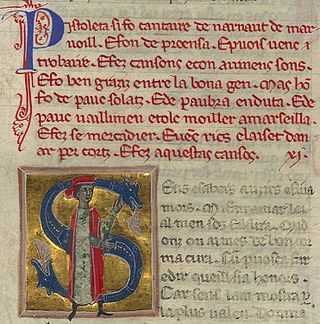
Pistoleta was a Provençal troubadour. His name means "little letter (epistle)" in Occitan. He left behind eleven songs, comprising nine cansos and two tensos. Some of his pieces are assigned to an otherwise unknown Jordan de Born in the table of contents of chansonnier C, a fourteenth-century Occitan manuscript.
Huguet de Mataplana was a Catalan nobleman and poet. His name, also spelled Uget, is the diminutive form of Hug, which is the Occitan version of "Hugh".
William I of Baux was the Prince of Orange from 1182 until his death. He was an important Provençal nobleman.

Bernart Alanhan de Narbona was a minor troubadour probably from Narbonne. He left behind only one song, No posc mudar qu'eu no diga, a sirventes about the loss of Jerusalem to the Saracens, though it was not classified as a Crusade song in the seminal work on the genre by Kurt Lewent (1905).
Manfred I, known as Manfredi Lancia, was the second Margrave of Busca, famous for his financial difficulties and his Occitan poetry. He was the first person to adopt the surname Lanza or Lancia, giving rise to the Lanza family.
Nationality words link to articles with information on the nation's poetry or literature.
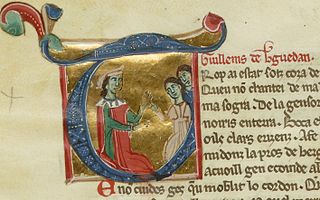
Guillem de Berguedà (c.1130–1195/6; fl.1138–1192), or Guilhem de Berguedan in Occitan, was a Catalan troubadour and viscount of Berguedà. He was the most prolific Catalan poet of the twelfth century, though he composed in Occitan, and thirty-one of his poems survive. Most are sirventes, "typically violent and obscene, reflecting his character and turbulent life," but there are a few cansos. Most of what is known about him derives from his vida and his songs.
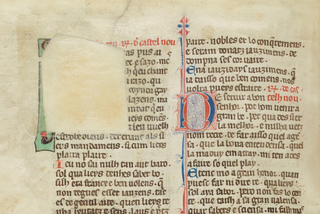
Raimon de Castelnou was an Occitan writer and troubadour of the second half of the 13th century. He wrote five cansos and one treatise on Catholic doctrine and ethics. There is a sirventes attributed to him in some manuscripts, but its attribution is disputed.